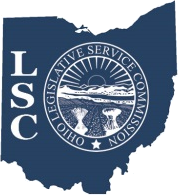And Drafting
Office
Section 101.68(B) of the Revised Code requires that when reports must be submitted to the General Assembly, copies of the reports must be submitted to the Director of the Legislative Service Commission (LSC). Section 101.68(C) requires LSC to monthly inform each member of the General Assembly of the reports received. Below is the annotated bibliography of reports recently submitted to LSC. The bibliography, compiled by the LSC Library staff, also includes other documents that may be of interest to legislators. The links to electronic copies of the documents are included; click "View Report" to open a document. Please call the LSC Library at (614) 466-5312 if you would like to receive more information about this document.
2020 ANNUAL REPORT ON EDUCATIONAL SERVICE CENTERS, November 2020, 20 pages
Report required by Section 265.505 of H.B. 166 of the 133rd General Assembly; describes how the Department partners with educational service centers to further the state's goals in the areas of quality schools, academic standards, educator preparation, and accountability and report cards; describes the general funding of educational service centers and provides the specific allocation to educational service centers to fund the partnerships.
FIRST QUARTER FINANCIAL REPORTS FOR FISCAL YEAR 2021, November 10, 2020, 7 pages + electronic zip file, 15.4 MB
Reports required by R.C. 3345.72; part one contains responses to 12 questions, designed to probe for serious cash flow problems, answered by the campus fiscal officer of all 37 of Ohio's state-supported colleges and universities for which the desired answer is no; 14 universities answered yes to at least one of the questions, mostly due to COVID-19 and some due to student refunds; contact the LSC Library for copies of the individual university reports.
OCCUPATIONAL REGULATION: A GUIDE TO STATE LAWS ON THE PRACTICE OF REGULATED OCCUPATIONS, 2020, 2103 pages
Report required by R.C. 103.27; the first biennial report, covering 33% of the state's current regulated occupations, is intended to assist the General Assembly in its review of associated agencies and occupational licensing boards; describes process used to assemble information to prepare the report, including the surveying of agencies and a review of surrounding state laws on the following topics: (1) education and training requirements, (2) experience requirements, (3) exam requirements, (4) continuing education requirements, (5) initial licensure fee, (6) license duration, and (7) renewal fee; report is accessible in sections at http://www.lsc.ohio.gov/pages/reference/current/occupationalregulation.aspx?GA=133.
STATE AND PERMISSIVE (LOCAL) SALES AND USE TAX COLLECTIONS FOR INDUSTRIES RELATED TO TRAVEL AND TOURISM, JANUARY 1, 2020 - JUNE 30, 2020, 2 pages
Report required by R.C. 5739.36; summarizes and publishes sales and use tax collections for industries related to travel and tourism for the reporting period.
ANNUAL REPORT, FISCAL YEAR 2020, 16 pages
Heavily designed with infographics to convey: overview of transporation system, table of organization, map of central and district offices, and construction summaries; includes financial statements; presents Department mission, vision, and guiding principles statements; describes critical success factors and grahically displays the factors on a dashboard and provides a link to the online dashboard that includes data about the factors from 2014 to 2020.
FINANCIAL AND STATISTICAL REPORT FISCAL YEAR 2020, 59 pages
Uses tables, graphs, and charts to present detailed information about funding sources, (state, federal, and bonds) and operating and capital appropriation uses; devotes one section to the State Infrastructure Bank; appendix includes a map and contact information for district offices, a list of contracts awarded in fiscal year 2020 by district, information about the collection and distribution of the state motor fuel tax and vehicle registration fees, descriptions of apportionment formulas for federal highway aid and federal transit programs, and maps of transit systems projects, general aviation airports, and active railroads.
PROPOSED 2021 OPERATING AND CAPITAL BUDGETS, November 12, 2020, 9 pages
Report required by R.C. 5537.17(H); cover letter notes the proposed operating budget reflects a $27.6 million decrease in revenues and a $0.5 million decrease in operating expenses from the last year's budget; cover letter also indicates the proposed capital expenditures include replacing 36.6 lane miles of the original concrete base pavement, resurfacing 39.5 lanes of roadway and one interchange, four bridge deck replacements, one bridge removal, continuation of the bridge painting program, and the continued modernization of the toll collection system; includes tentative listing of all the capital projects planned for 2021.
OHIO BUREAU OF WORKERS' COMPENSATION 2020 MORTALITY STUDY, July 7, 2020, 71 pages
Report required by R.C. 4121.125; transmittal letter dated October 30, 2020; summarizes completed actuarial investigation of the mortality actuarial assumptions; prepared by Oliver Wyman Actuarial Consulting, Inc.
UNPAID LOSS AND LOSS ADJUSTMENT EXPENSE AS OF JUNE 30, 2020, August 14, 2020, 43 pages
Report required by R.C. 4121.125; transmittal letter dated October 30, 2020; summarizes the annual actuarial analysis of unpaid liabilities of the state insurance funds and all other funds under ORC chapters 4121, 4123, 4127, and 4131; prepared by Oliver Wyman Actuarial Consulting, Inc.; specifically includes: (1) a summary of the funds and components evaluated, (2) a description of the actuarial methods and assumptions used in the analysis of the unpaid liabilities, and (3) a schedule showing the differences in estimates of unpaid liabilities since the previous annual actuarial analysis report.
